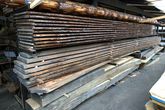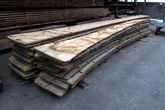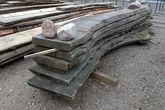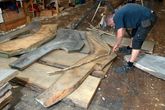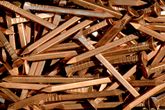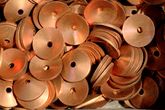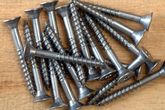Materials for the eel drifter
'Oak on oak', as they say in the trade, when both strakes and frames are made of oak.
Traditionally, boats in Denmark have been built from different types of wood. 'Oak on oak', 'pine on oak' (pine planks and oak frames) or 'larch on oak' have however been the most common choices for Danish clinker-built working boats. This eel drifter has been built in 'oak on oak'.
Boatbuilders have always had differing opinions about and traditions for, which materials were best to use when building boats. One particular type of wood can for example have a very high breaking strength, but very little flexibility. Therefore, different types of wood are used for different purposes. The selection is made on the basis of an analysis of the wood's strength, weight, longevity, appearance, growth pattern and so on.
And what should be the highest priority? Birch is stronger than oak, for example, but doesn't last nearly as long and is therefore almost never used in ship and boat building. Wood types for masts have also been diverse. Pine, larch, Douglas spruce or Norwegian spruce have all been used. We use Norwegian spruce because it is light and because it provides good, slow-grown, straight timbers.
In recent years, sails have been made of cotton, but in the old days, linen and hemp were also used to make sail canvas. This boat was not built for the museum, but for a private client, so we used modern ClipperCanvas, a synthetic material that looks like cotton sail cloth but lasts much longer.
Ropes would have been made of tarred hemp or from manilla, a product made from the leaf fibres of the banana palm. We use synthetic hemp, which looks like a natural fibre but lasts longer and doesn't require any maintenance. Synthetic hemp is also much more flexible than real hemp, and therefore cannot always replace authentic hemp rope.
Click on the photos to enlarge them...
Crooked timbers
The crooked timbers are also carefully selected oak pieces. We have either selected them from the forest and taken them from the crowns of oak trees, or they have been chosen at sawmills, where they were cut to the correct dimensions.
The timbers for the keel, stem, sternpost and gunwale were bought from Gilleleje Shipyard and Havnsø Boatbuilders, where they had timbers in stock.
Copper nails
We used copper clinker nails for the drifter, because they last better than iron nails. Originally (around 1900), galvanised iron nails would have been used. Copper was used for leisure craft, but it was not until the 1950's that traditional boatbuilders also began to build with copper nails.
The copper nails are called 4x65, because they are 4mm thick and 65mm long.
These copper roves measure 19mm in diameter.
Roves have been circular in shape since they began to be produced by machine, ca. 100 - 150 years ago. Before this, they were square in shape. Archaeologists have found long strips of flat iron with holes bored in them, dating to the Viking Age. Using a chisel, these strips would be cut into small square pieces and used as roves for clinker nails.
Before it was possible to galvanise iron, nails were protected against rust by coating the hot iron with tar.
We use acid-resistant, stainless steel screws in the rabbet and frames under the waterline, instead of the galvanised spikes that would have been used originally.
We are not building an old drifter, or even a copy of an old boat - rather, we are building a new boat which is inspired by the old. That means that it will have the same appearance and capabilities, but also that we have replaced galvanised nails with acid-resistant stainless steel, which has a much greater longevity.
The ship's nails are hot-dip galvanised. Today, these so-called, 'Danish ship's nails' are actually produced in India, because there is not enough demand for them here in Denmark.
